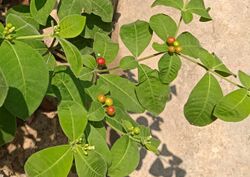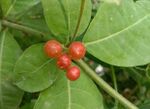Biology:Rauvolfia tetraphylla
| Rauvolfia tetraphylla | |
|---|---|

| |
| Scientific classification | |
| Kingdom: | Plantae |
| Clade: | Tracheophytes |
| Clade: | Angiosperms |
| Clade: | Eudicots |
| Clade: | Asterids |
| Order: | Gentianales |
| Family: | Apocynaceae |
| Genus: | Rauvolfia |
| Species: | R. tetraphylla
|
| Binomial name | |
| Rauvolfia tetraphylla | |
| Synonyms[1] | |
| |
Rauvolfia tetraphylla is a plant in the family Apocynaceae, growing as a bush or small tree. It is commonly known as the be still tree[2] or devil-pepper. The plant is native to Mexico, Central America, West Indies, and northern South America. It has been cultivated widely as both an ornamental and for use in traditional medicine.[citation needed] It is now naturalized throughout the tropics including Australasia, Indochina, and India .
Rauvolfia tetraphylla fruits are called devil-peppers and hold an important position in the Indian traditional system of medicine.[citation needed] The plant has various significances and it is widely used by South Indian tribes.
Asima Chatterjee initiated chemical investigation of alkaloids in Rauvolfia tetraphylla then known as Rauwolfia canescens. Indole alkaloids including serpentine, reserpine, serpentinine, and other Rauwolfia alkaloids were identified in phytochemical study. [citation needed]
References
- ↑ "Rauvolfia tetraphylla - Synonyms". http://www.theplantlist.org/tpl1.1/record/kew-176987. Retrieved 23 September 2017.
- ↑ "Rauvolfia tetraphylla". Natural Resources Conservation Service PLANTS Database. USDA. https://plants.usda.gov/core/profile?symbol=RATE8. Retrieved 19 October 2015.
Wikidata ☰ Q3595081 entry
 |






